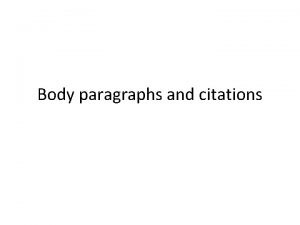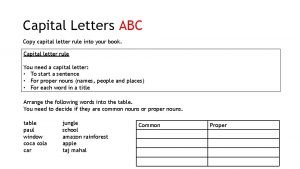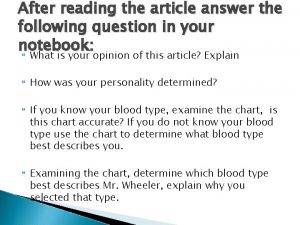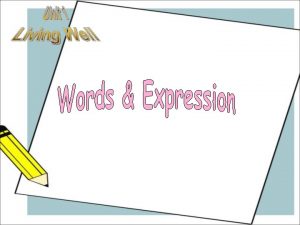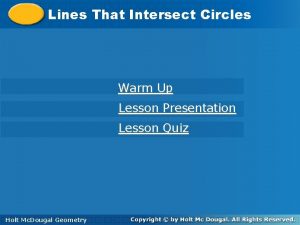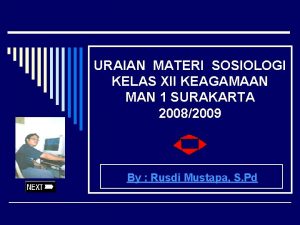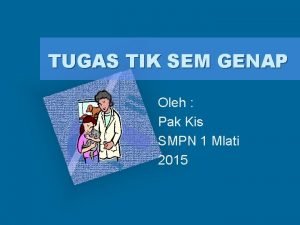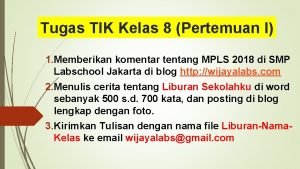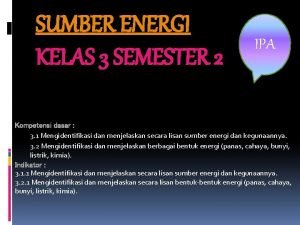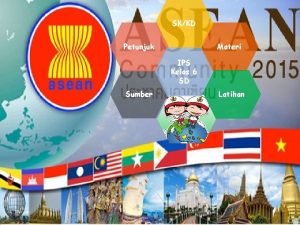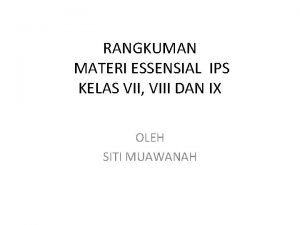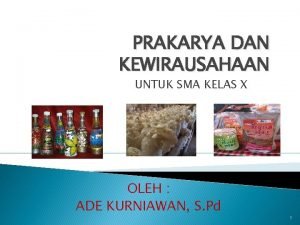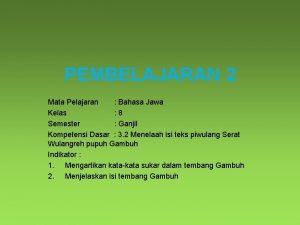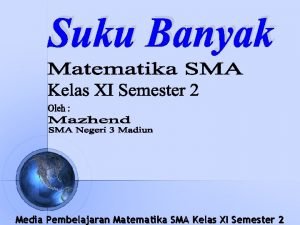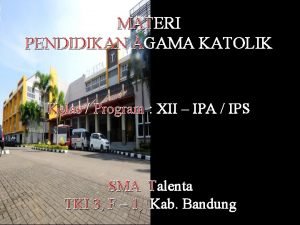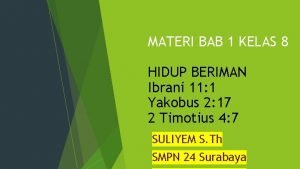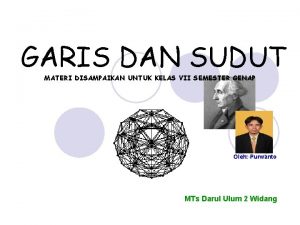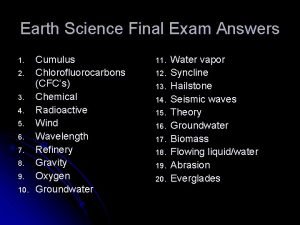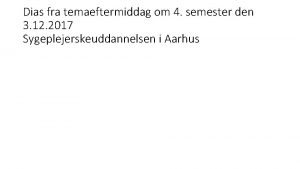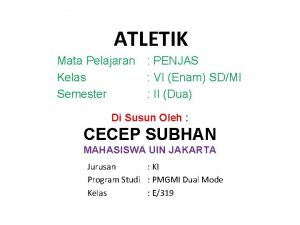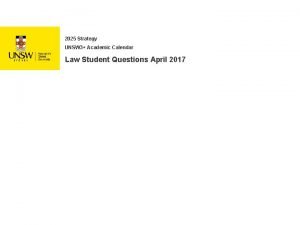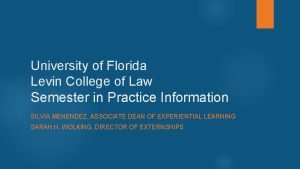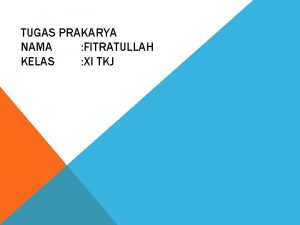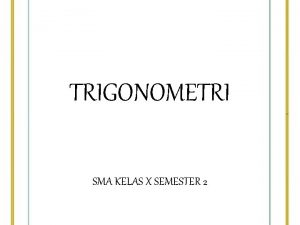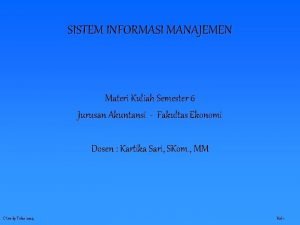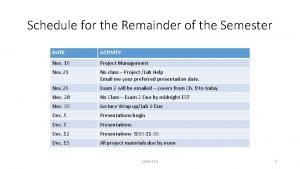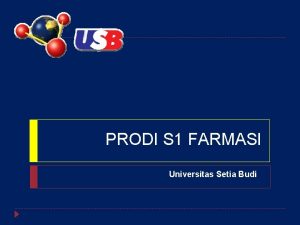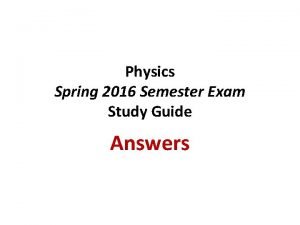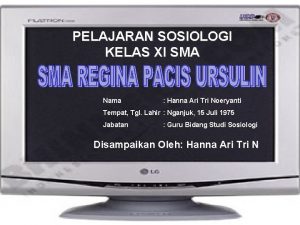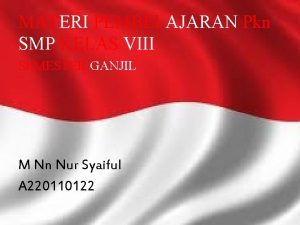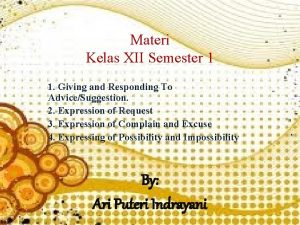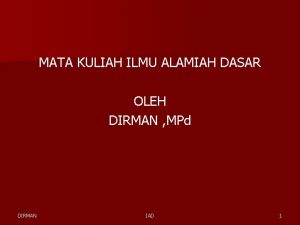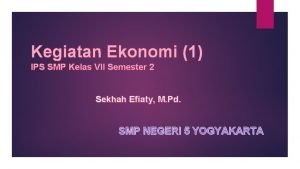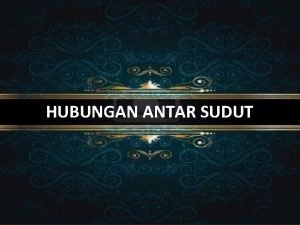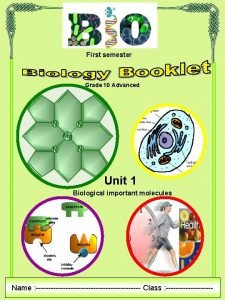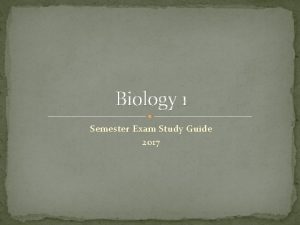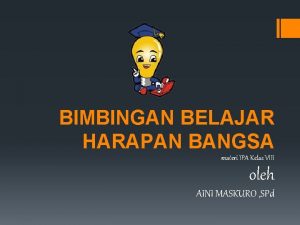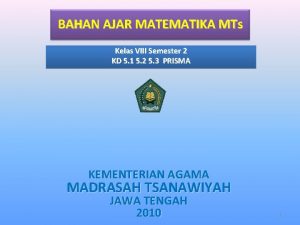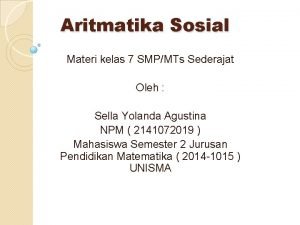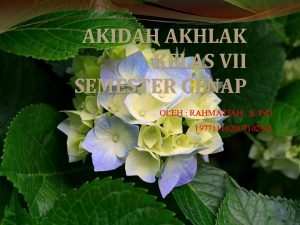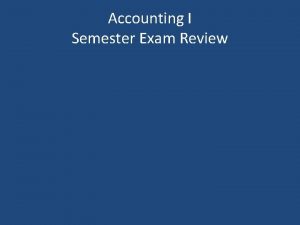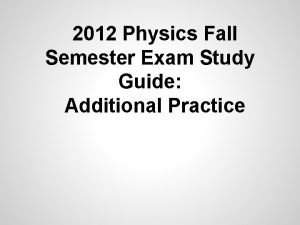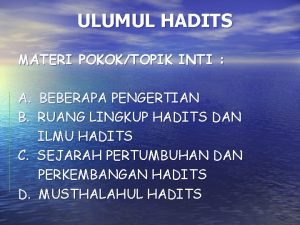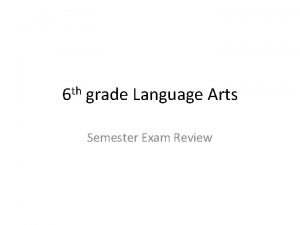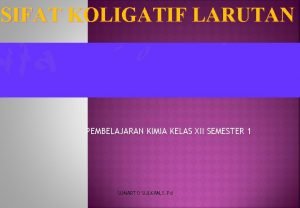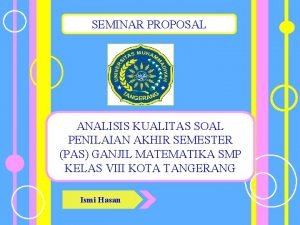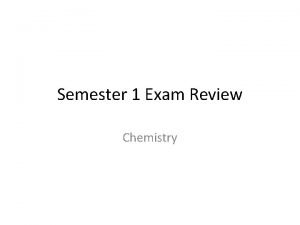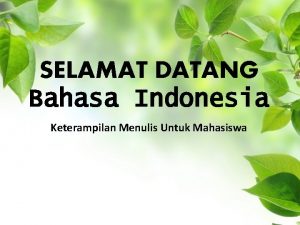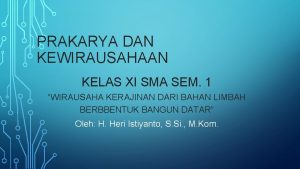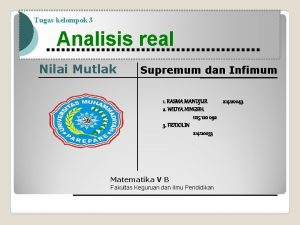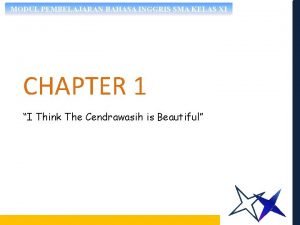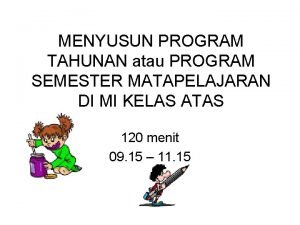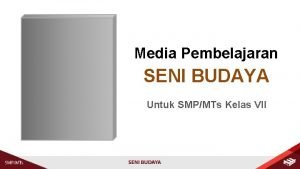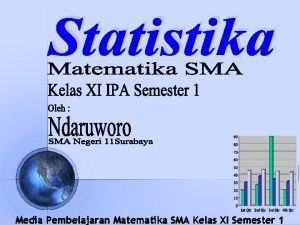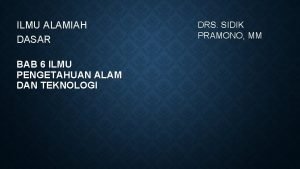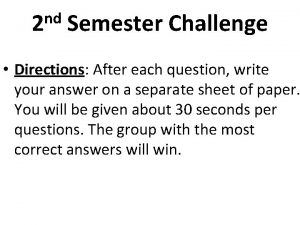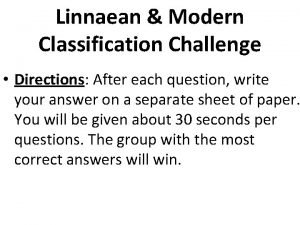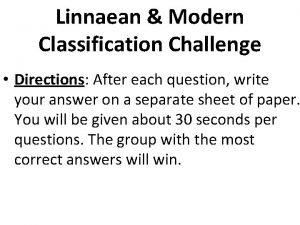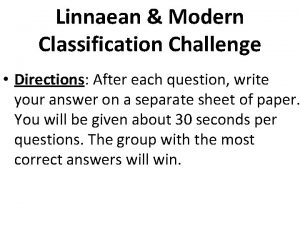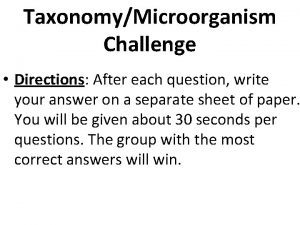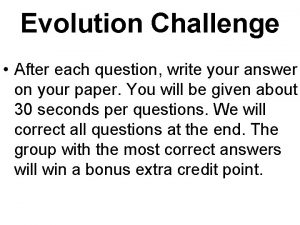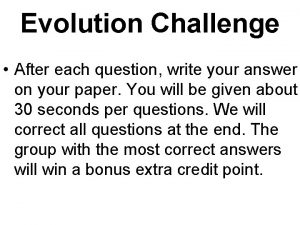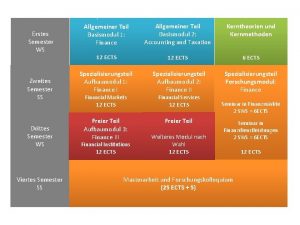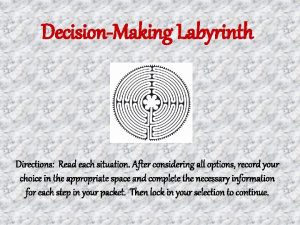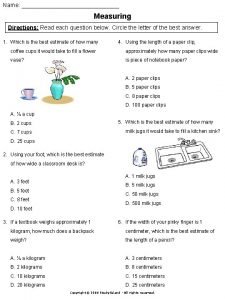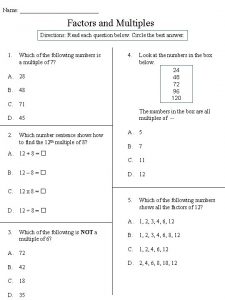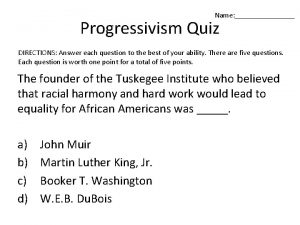nd 2 Semester Challenge Directions After each question











































































































- Slides: 107

nd 2 Semester Challenge • Directions: After each question, write your answer on a separate sheet of paper. You will be given about 30 seconds per questions. The group with the most correct answers will win.

Evolution 10 questions

1 of 10) If you had the bacteria infection growing in the picture below, name all the antibiotics you could use.

2 of 10) Which law of geology states that newer rock layers form on top of older rock layers?

3 of 10) Which type of isolation is shown in this picture?

4 of 10) Which two vestigial structures indicates humans once had a more plant-rich diet?

5 of 10) Which groups of animals may be linked together by the archaeopteryx fossil?

6 of 10) Which organic molecules were Miller & Urey able to create from inorganic molecules in their famous experiment?

7 of 10) When do these different species look most similar?

8 of 10) As explained in theory of evolution by natural selection, organisms with adaptations are more likely to survive and _____.

9 of 10) What is the process called when many species evolve from 1 original ancestral species?

10 of 10) Which structures have similar structures but differing functions?

Exchange Your Answers

1 of 10) If you had the bacteria infection growing in the picture below, name all the antibiotics you could use.

2 of 10) Which law of geology states that newer rock layers form on top of older rock layers?

3 of 10) Which type of isolation is shown in this picture?

4 of 10) Which two vestigial structures indicates humans once had a more plant-rich diet?

5 of 10) Which groups of animals may be linked together by the archaeopteryx fossil?

6 of 10) What were Miller & Urey able to create from inorganic molecules in their famous experiment?

7 of 10) When do these different species look most similar?

8 of 10) As explained in theory of evolution by natural selection, organisms with adaptations are more likely to survive and _____.

9 of 10) What is the process called when many species evolve from 1 original ancestral species?

10 of 10) Which structures have similar structures but differing functions?

Ecology 10 questions

1 of 10) How many trophic levels is the longest food chain?

2 of 10) Ants live inside this acacia plant and in return defend the plant from herbivores. Which type of symbiotic relationship is this?

3 of 10) Identify the stages of the water cycle from the choices below. Choices: Evaporation Infiltration Transpiration Condensation Run-off Precipitation

4 of 10) Name the layer of the Earth where all life can be found.

5 of 10) What is the carrying capacity of this microscopic Daphnia population?

6 of 10) Two part question: A) The ozone layer is thinning because of which man-made chemical? B) What is striking the earth as a result of the thinning ozone layer?

7 of 10) The fish gains protection from predators, but the anemone is neither helped nor hurt. Which symbiotic relationship is this?

8 of 10) How many kcal would the eagle receive?

9 of 10) Pollutants are absorbed by the producers below and accumulate as you move up the food chain. This is an example of which environmental problem?

10 of 10) CO 2, methane, and water vapor in the earth’s atmosphere absorbs heat. This natural process is known as the _____.

Exchange Your Answers

1 of 10) How many trophic levels is the longest food chain?

2 of 10) Ants live inside this acacia plant and in return defend the plant from herbivores. Which type of symbiotic relationship is this?

3 of 10) Identify the stages of the water cycle from the choices below. Choices: Evaporation Infiltration Transpiration Condensation Run-off Precipitation

4 of 10) Name the layer of the Earth where all life can be found.

5 of 10) What is the carrying capacity of this microscopic Daphnia population?

6 of 10) Two part question: A) The ozone layer is thinning because of which man-made chemical? B) What is striking the earth as a result of the thinning ozone layer?

7 of 10) The fish gains protection from predators, but the anemone is neither helped nor hurt. Which symbiotic relationship is this?

8 of 10) How many kcal would the eagle receive?

9 of 10) Pollutants are absorbed by the producers below and accumulate as you move up the food chain. This is an example of which environmental problem?

10 of 10) CO 2, methane, and water vapor in the earth’s atmosphere absorbs heat. This natural process is known as the _____.

Physiology 10 questions

1 of 10) Which tissue supports the body and includes bones and ligaments?

2 of 10) Label the eye diagram. Choices: Retina Cornea Pupil Cochlea Optic nerve Iris Lens

3 of 10) Name the inner ear bone that leads to the auditory nerve?

4 of 10) Three part question. A) Name the body system pictured. B) Which letter identifies the hypothalamus? C) Which component of homeostasis does the hypothalamus control?

5 of 10)During negative feedback, which organ senses high blood glucose levels and then responds to help lower the level?

6 of 10) Label the objects of the neuron below. Choices: Neurotransmitters Impulse Plasma membrane Vesicle Schwann cell Synapse Receptor

7 of 10) List all the blood types that a B+ person can receive in a transfusion.

8 of 10) Name the proteins found on the surface of cells to help identify them as belonging to yourself.

9 of 10) Match the sense with the nerve. Sense Nerve Smell Auditory Sight Olfactory Hearing Cranial Taste Optical

10 of 10) Label the 3 main parts of a neuron. A C B

Exchange Your Answers

1 of 10) Which tissue supports the body and includes bones and ligaments?

2 of 10) Label the eye diagram. Choices: Retina Cornea Pupil Cochlea Optic nerve Iris Lens

3 of 10) Name the inner ear bone that leads to the auditory nerve?

4 of 10) Three part question. A) Name the body system pictured. B) Which letter identifies the hypothalamus? C) Which component of homeostasis does the hypothalamus control?

5 of 10)During negative feedback, which organ senses high blood glucose levels and then responds to help lower the level?

6 of 10) Label the objects of the neuron below. Choices: Neurotransmitters Impulse Plasma membrane Vesicle Schwann cell Synapse Receptor

7 of 10) List all the blood types that a B+ person can receive in a transfusion.

8 of 10) Name the proteins found on the surface of cells to help identify them as belonging to yourself.

9 of 10) Match the sense with the nerve. Sense Nerve Smell Auditory Sight Olfactory Hearing Cranial Taste Optical

10 of 10) Label the 3 main parts of a neuron. A C B

Classification 6 questions

1 of 6) Besides the animal kingdom, which other kingdom is 100% heterotrophic?

2 of 6) Which kingdom of life is best described by the following: Usually unicellular Mostly heterotrophs Reproduce sexually and asexually Eukaryotic

3 of 6) Humans and chimps share the same “order” of classification called Primates. Besides their “order” which other levels of classification do they have in common?

4 of 6) How many traits do primates and crocodiles have in common?

5 of 6) Which trait distinguishes amphibians from primates?

6 of 6)Handwrite the proper binomial name (correct format) for human beings.

Exchange Your Answers

1 of 6) Besides the animal kingdom, which other kingdom is 100% heterotrophic?

2 of 6) Which kingdom of life is best described by the following: Usually unicellular Mostly heterotrophs Reproduce sexually and asexually Eukaryotic

3 of 6) Humans and chimps share the same “order” of classification called Primates. Besides their “order” which other levels of classification do they have in common?

4 of 6) How many traits do primates and crocodiles have in common?

5 of 6) Which trait distinguishes amphibians from primates?

6 of 6)Handwrite the proper binomial name (correct format) for human beings. Capitalized Lower-case

Microorganisms 10 questions

1 of 10) In order, name the 5 stages of the lytic cycle?

2 of 10) Which of the following shows the proper steps of a retrovirus? a) DNA RNA Amino acids Protein b)DNA Amino acids RNA Proteins c) RNA Amino acids Protein d)DNA RNA DNA Amino acids Protein e) Proteins Amino acids RNA DNA f) RNA DNA RNA Amino acids Protein

3 of 10) Two part question: a) What is the outer covering of a virus called? B) What is it made from?

4 of 10) Three part question: Which traits are most common in bacteria? Part A) Reproduction: Asexual or Sexual Part B) Feeding: Autotrophs or Heterotrophs Part C) Cell type: Prokaryote or Eukaryote

5 of 10) Two part question: a) Which letter is used to anchor bacteria? b) Name this bacteria part.

6 of 10) Which letter shows cocci shaped bacteria?

7 of 10) The picture below shows an amoeba. Which part does the arrow identify?

8 of 10) Name these specific types of plant- like protista with glass-like shells.

9 of 10) Label the four parts of the fungus diagram.

10 of 10) Which category of fungus are identified in the pictures?

Exchange Your Answers

1 of 10) In order, name the 5 stages of the lytic cycle?

2 of 10) Which of the following shows the proper steps of a retrovirus? a) DNA RNA Amino acids Protein b)DNA Amino acids RNA Proteins c) RNA Amino acids Protein d)DNA RNA DNA Amino acids Protein e) Proteins Amino acids RNA DNA f) RNA DNA RNA Amino acids Protein

3 of 10) Two part question: a) What is the outer covering of a virus called? B) What is it made from?

4 of 10) Three part question: Which trait is most common in bacteria? Part A) Reproduction: Asexual or Sexual Part B) Feeding: Autotrophs or Heterotrophs Part C) Cell type: Prokaryote or Eukaryote

5 of 10) Two part question: a) Which letter is used to anchor bacteria? b) Name this bacteria part.

6 of 10) Which letter shows cocci shaped bacteria?

7 of 10) The picture below shows an amoeba. Which part does the arrow identify?

8 of 10) Name these specific types of plant-like protista with glass-like shells.

9 of 10) Label the four parts of the fungus diagram.

10 of 10) Which category of fungus are identified in the pictures?

Plants 10 questions

4 of 21) Plants like moss and ferns must live in watery/moist environments because they are ______. A. Nonvascular B. Vascular C. Seed-producing D. Monocots E. Dicots F. Seedless G. Angiosperms H. Gymnosperms

13 of 21) Three part question. A) Name A. B) Name part B. C) Which process occurs at part B?

Exchange Your Answers
 After me after me after me
After me after me after me John 14:1-3
John 14:1-3 Examples of level three questions
Examples of level three questions Whitchester house
Whitchester house How to write a direction essay
How to write a direction essay Is it a capital letter after a colon
Is it a capital letter after a colon Read the following articles
Read the following articles After reading the article answer the following question
After reading the article answer the following question Present simple question words
Present simple question words Closed question
Closed question Contoh open ended question adalah
Contoh open ended question adalah Factor-relating
Factor-relating Direct question vs indirect question
Direct question vs indirect question Examples of compelling and supporting questions
Examples of compelling and supporting questions Examples of compelling questions
Examples of compelling questions Look at the picture then answer the question
Look at the picture then answer the question Complete each sentence with a question tag
Complete each sentence with a question tag Answer each question
Answer each question Rewrite each expression using the properties of exponents
Rewrite each expression using the properties of exponents Identify each line or segment that intersects each circle
Identify each line or segment that intersects each circle Materi sosiologi kelas 12
Materi sosiologi kelas 12 Materi desain grafis kelas 10 semester 2
Materi desain grafis kelas 10 semester 2 Us history final exam semester 1
Us history final exam semester 1 Tugas tik kelas 9 semester 2
Tugas tik kelas 9 semester 2 Tugas tik kelas 8 semester 2
Tugas tik kelas 8 semester 2 Chemistry semester 2 review unit 12 thermochemistry
Chemistry semester 2 review unit 12 thermochemistry Terompet gitar dan suling merupakan contoh sumber energi
Terompet gitar dan suling merupakan contoh sumber energi Materi ips sd kelas 6
Materi ips sd kelas 6 Wharton mbacm
Wharton mbacm English semester 2 final exam
English semester 2 final exam English 11 semester exam
English 11 semester exam Pointing
Pointing Materi segitiga smp kelas 7 semester 2
Materi segitiga smp kelas 7 semester 2 Rangkuman materi ips kelas 7 semester 1
Rangkuman materi ips kelas 7 semester 1 Ppt prakarya dan kewirausahaan kelas xi semester 1
Ppt prakarya dan kewirausahaan kelas xi semester 1 Rumus modus
Rumus modus Materi mice kelas 11 semester 2
Materi mice kelas 11 semester 2 Pitutur ingkang sayektos tegese
Pitutur ingkang sayektos tegese Materi dana kas kecil kelas 12
Materi dana kas kecil kelas 12 Administrasi keuangan kelas 11
Administrasi keuangan kelas 11 Teorema faktor
Teorema faktor Ringkasan materi agama katolik kelas xii semester 2
Ringkasan materi agama katolik kelas xii semester 2 Rangkuman agama kristen kelas 8 semester 1
Rangkuman agama kristen kelas 8 semester 1 Honors physics semester 2 review
Honors physics semester 2 review Gambar
Gambar World history semester 2 final review packet
World history semester 2 final review packet World history semester 2 review
World history semester 2 review Environmental science final
Environmental science final Earth science final exam answers
Earth science final exam answers Forudsætningskrav sygeplejerske 1 semester
Forudsætningskrav sygeplejerske 1 semester Semester vs trimester
Semester vs trimester Materi atletik kelas 5 sd
Materi atletik kelas 5 sd Us history semester 2 final exam review
Us history semester 2 final exam review Algebra 1 final review packet
Algebra 1 final review packet Unsw semester dates 2019
Unsw semester dates 2019 Uf law externship
Uf law externship Tugas prakarya kelas 11
Tugas prakarya kelas 11 Trigonometri kelas 10 semester 2
Trigonometri kelas 10 semester 2 Kompetensi dasar fisika kelas 11 semester 1
Kompetensi dasar fisika kelas 11 semester 1 Spanish 1 answers
Spanish 1 answers Materi sistem informasi manajemen semester 5
Materi sistem informasi manajemen semester 5 Pengantar teknologi informasi semester 1
Pengantar teknologi informasi semester 1 Humss scheduling of subjects
Humss scheduling of subjects American literature semester 1 final
American literature semester 1 final Remainder of the semester
Remainder of the semester Mary is trying hard in school this semester her father said
Mary is trying hard in school this semester her father said Edumanage usb
Edumanage usb Physics semester 1 final exam study guide answers
Physics semester 1 final exam study guide answers Peta konsep sosiologi kelas 11
Peta konsep sosiologi kelas 11 Materi pembelajaran pkn smp kelas 8 semester 2
Materi pembelajaran pkn smp kelas 8 semester 2 Materi kelas 12 semester 1
Materi kelas 12 semester 1 Garis yang memotong bidang lmro adalah
Garis yang memotong bidang lmro adalah Materi kuliah ilmu alamiah dasar semester 2
Materi kuliah ilmu alamiah dasar semester 2 Contoh soal matematika diskrit kuliah
Contoh soal matematika diskrit kuliah Kegiatan ekonomi kelas 7 semester 2
Kegiatan ekonomi kelas 7 semester 2 Sudut sepihak dalam
Sudut sepihak dalam Biology grade 10 unit 3
Biology grade 10 unit 3 Zoology semester 1 exam review answers
Zoology semester 1 exam review answers English 12 semester 1 final exam
English 12 semester 1 final exam Biology 1st semester study guide
Biology 1st semester study guide Geometry unit 1 review
Geometry unit 1 review Rangkuman ipa kelas 9
Rangkuman ipa kelas 9 Sebuah roti berbentuk prisma dengan alas jajargenjang
Sebuah roti berbentuk prisma dengan alas jajargenjang Peta konsep aritmatika sosial beserta penjelasannya
Peta konsep aritmatika sosial beserta penjelasannya Apes semester 1 final exam
Apes semester 1 final exam World history 1st semester final review answers
World history 1st semester final review answers Materi akidah akhlak kelas 7 semester genap
Materi akidah akhlak kelas 7 semester genap Accounting semester 1 exam
Accounting semester 1 exam Physics fall semester exam review
Physics fall semester exam review Is cal poly pomona quarter or semester
Is cal poly pomona quarter or semester Materi ulumul hadits semester 1
Materi ulumul hadits semester 1 English 3 fall semester exam review
English 3 fall semester exam review Fraksi mol
Fraksi mol Proposal penilaian akhir semester smp
Proposal penilaian akhir semester smp Chemistry semester 1 exam study guide answers
Chemistry semester 1 exam study guide answers Bahasa melayu selamat datang
Bahasa melayu selamat datang Aktivitas 1 pkwu kelas 11 semester 1
Aktivitas 1 pkwu kelas 11 semester 1 Mata kuliah pip
Mata kuliah pip Modul matematika kelas 10 semester 1
Modul matematika kelas 10 semester 1 Modul pembelajaran sma bahasa inggris
Modul pembelajaran sma bahasa inggris Menyusun program tahunan dan program semester
Menyusun program tahunan dan program semester Media ragam hias
Media ragam hias Materi matematika kelas 11 semester 1
Materi matematika kelas 11 semester 1 Pelajaran ips
Pelajaran ips Perbedaan ilmu alamiah dasar dan ilmu pengetahuan alam
Perbedaan ilmu alamiah dasar dan ilmu pengetahuan alam Hope semester 1 exam answers
Hope semester 1 exam answers World history semester 1 final exam study guide answers
World history semester 1 final exam study guide answers Biology semester 1 review 2018
Biology semester 1 review 2018




